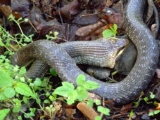
Aesculapian Snake
Encyclopedia
The Aesculapian Snake is a nonvenomous snake
native to Europe
.
List of Snakes
List of reptiles of Europe
Snake
Snakes are elongate, legless, carnivorous reptiles of the suborder Serpentes that can be distinguished from legless lizards by their lack of eyelids and external ears. Like all squamates, snakes are ectothermic, amniote vertebrates covered in overlapping scales...
native to Europe
Europe
Europe is, by convention, one of the world's seven continents. Comprising the westernmost peninsula of Eurasia, Europe is generally 'divided' from Asia to its east by the watershed divides of the Ural and Caucasus Mountains, the Ural River, the Caspian and Black Seas, and the waterways connecting...
.
Description
They hatch at around 30 cm (11.8 in) and average at around 110 cm (43.3 in) but can grow up to 200 cm (78.7 in). They are dark, long, slender, and shiny. Juveniles can easily be confused with juvenile Grass snakes, also having a yellow collar on their neck. Juveniles are light green or brownish-green with various darker patterns along the flanks and on their back. They appear to have two darker patches in the form of lines running on the top of the flanks. Adults are much more uniform, sometimes being olive-yellow, brownish-green, sometimes almost black. When they have a pale color, sometimes two darker lines can be visible, but if their body color is dark, they usually have white freckles all over their body. Their belly is yellow.Geographic Range
Found over most of France except in the north, the Spanish Pyrenees and the eastern side of the Spanish northern coast, Italy (except the south and Sicily), the Balkan peninsula and parts of Switzerland and Austria. Some isolated populations in western Germany and in the northwest of the Czech Republic.Diet
Their main food source are rodents. They also eat lizards and sometimes bird eggs as well as birds. They constrict their prey. Juveniles eat mainly lizards.Behavior
They can be rather tame, confident that their coloration will keep them hidden within their natural environment. They usually disappear and hide, but if cornered they may sometimes stand their ground and try to intimidate their opponent, sometimes with a chewing-like movement of the mouth and occasionally biting. They are active by day. In the warmer months of the year, they come out in late afternoon or early morning. They are very good climbers.Reproduction
Breeding occurs when the snakes wake up from hibernation in spring, a week after, they are all looking for each other and mating begins. After only a few weeks about 15 eggs are laid (extremes are from 9 to 20 eggs) in a moist, warm spot, usually under hay piles, in rotting wood piles and other places of this kind. The eggs incubate for around 10 weeks before hatching.See also
List of reptiles of ItalyList of Snakes
List of reptiles of Europe

